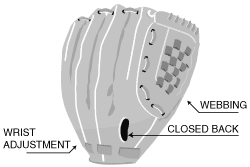|
How To Buy A Baseball/Sofball Glove
Gloves, like the hands they fit, come in a variety of sizes. Baseball and softball gloves also are geared to fit both the position you play and the level of your game. Keep these factors in mind when you decide which style, size, features and materials best suit your game.
- Gloves by Fielding Position
- Catcher
- First base
- Infield
- Outfield
- Softball
- Find the Features that Fit Your Game
- Fit the Glove to Your Hand
- Buying a Ball
- Gloves by Fielding Position
Gloves are made to better help you field your position. A key element in determining the size mitt you buy is the position you play in the field.
Catcher
- A fingerless mitt (it does not have individual fingers)
- Has heavy padding to reduce the sting from the pitcher's throw
- Reinforced to withstand the heavy use throughout a game
- Also resembles a mitten, but has less padding than the catcher's mitt
- It is longer to help the first baseman field throws from infielders
- A shallow pocket allows the first baseman to quickly retrieve the ball from the mitt
- A five-fingered glove with a shallow pocket
- A youth size is between 9 - 11 inches
- Adults 10 1/2 to 11 1/2 inch is the typical baseball size
- Softball infielder gloves have a deeper pocket to accept the bigger ball
- Second basemen need a smaller glove to help make those quick throws while still having control
- Shortstops use something in the middle for grounders and quick throws
- Third basemen need a larger glove
- Usually sized at 12 to 12 1/2-inches for adults, about 11 inches for children
- A deeper pocket to handle balls hit high in the air
- Longer length to give as much reach as possible
- If you plan to play several positions, find a glove that provides the most control for a variety of outfield positions
- Generally larger both in the pocket and length to help players handle the larger ball
- If you play both baseball and softball, and you only want to buy one glove, select a softball glove
- Find the Features that Fit Your Game
Today's gloves have different features built-in to help your game and to suit your ability. Here are the key features constructed into gloves and what to consider in finding the glove that suits you.
|

